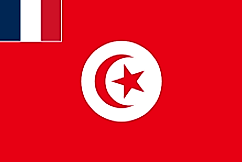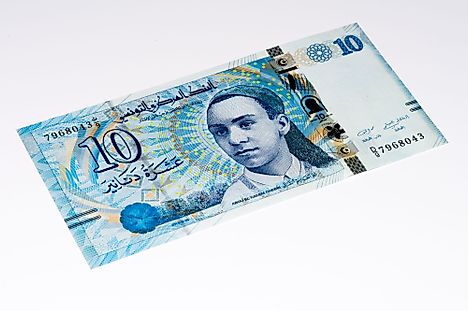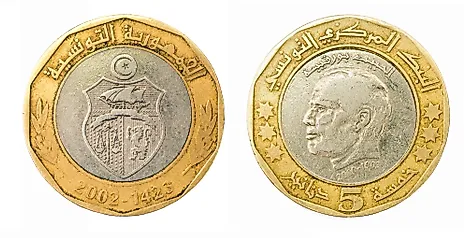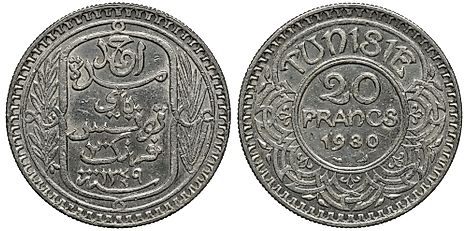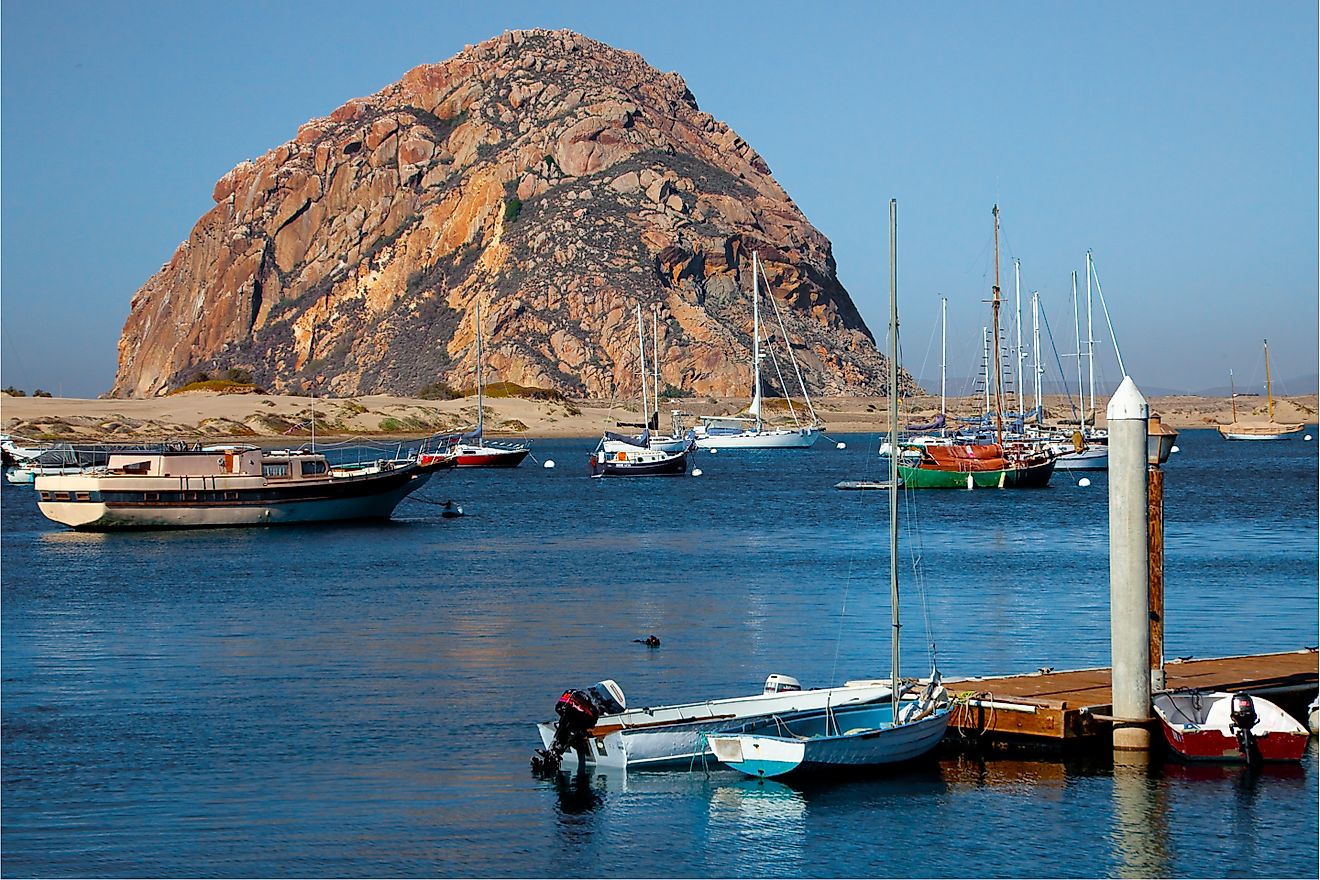Flags, Symbols & Currency of Tunisia
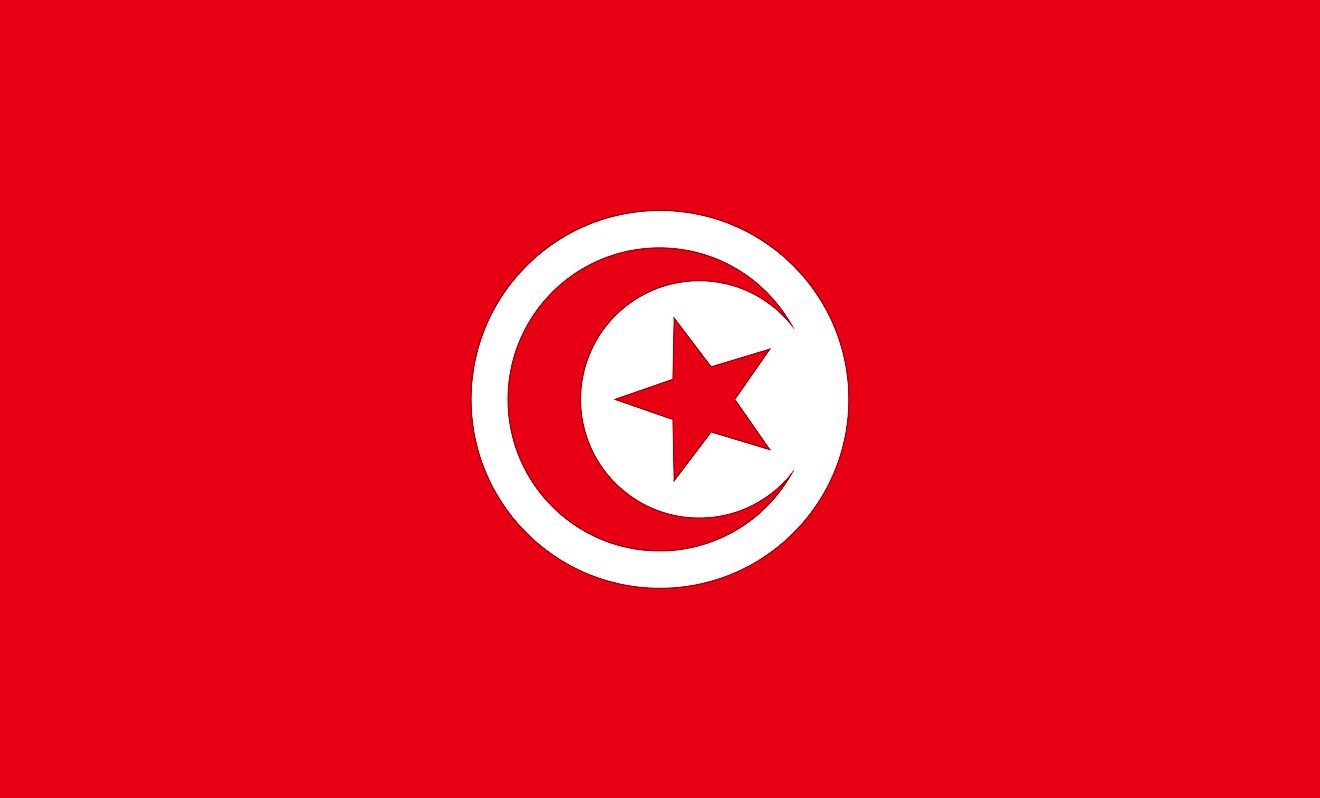
The National Flag of Tunisia was officially adopted on October 20, 1827. The flag has been designed by Al-Husayn II ibn Mahmud.
The National Flag of Tunisia is rectangular in shape and features a red background with a white disk at the center, that bears a red crescent nearly encircling a red five-pointed star. The red crescent is made up to two intersecting arcs and surrounds the star on its left. The red color represents the resistance against Turkish dominance and the blood shed by martyrs killed in 1881 when Tunisia was conquered by France. The red color on the flag also symbolizes Islam, which is the predominant religion in Tunisia. The red crescent is a traditional indication of Islam and also serves as a sign of good luck in Arabic culture, as well as representing the unity of all Muslims. The white color symbolizes peace, whereas the white disk represents the sun. The star, like the crescent, is an ancient symbol of the Islamic religion, and the star’s five points symbolize the Five Pillars of Islam: faith, prayer, charity, fasting, and the annual pilgrimage to Mecca. The flag has width to length proportions of 2:3.
History of the Flag of Tunisia
In the 18th century, most of Tunisia's maritime flags featured a crescent oriented shape with blue, red, green and white colors. When Tunisia was part of the Ottoman Empire, its naval ensign had blue, green and red horizontal stripes. The Bey of Tunis also had a flag in the 19th century, which was used in public celebrations and appeared on Tunisia's coat of arms. The flag was rectangular in shape and included nine stripes alternating between yellow and red, while the middle line was green. As a French Protectorate, Tunisia's flag featured a small French flag in the upper left corner. This flag was used from 1943 until 1956. Before the current design, the national flag, which was used between 1959 and 1999, was Tunisia’s naval ensign which had a slightly narrower crescent. The current flag originated from the naval ensign of the Kingdom of Tunis, and was designed in 1831 by Al-Husayn II ibn Mahmud, who was the Bey of Tunis from 1824 until 1835. As a former part of the Ottoman Empire, the Tunisian flag also exhibits similarities to the Ottoman flag.
Symbols of Tunisia
The National Coat of Arms of Tunisia
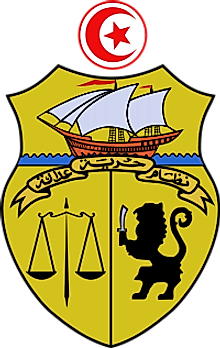
The Tunisian coat of arms is composed of a shield which features a ship, a lion holding a sword and a scale. The ship is representative of freedom, the lion for order, and the scale symbolizes justice. Below the ship, in the center of the shield is the National Motto, inscribed in Arabic: “Freedom, Order, Justice”. The red crescent and star placed on a white disk, that forms the central emblem of the national flag is positioned above the shield. The background of the shield with all its sections are golden in color.
National Motto
“Freedom, Order, Justice”
National Anthem
- Anthem Title: "Ḥumāt al-Ḥimá" ("Defenders of the Homeland")
- Music Composer: Mohamad Abdel Wahab
- Lyricist: Mustafa Sadik Al-Rafii and Aboul-Qacem Echebbi
- Date of Adoption: November 7, 1987
"Ḥumāt al-Ḥimá" ("Defenders of the Homeland") is the national anthem of Tunisia. The muisc of the anthem have been composed by Mohamad Abdel Wahab. The lyrics of the anthem have been authored by both Mustafa Sadik Al-Rafii and Aboul-Qacem Echebbi. The anthem was officially adopted on November 7, 1987.
حماة الحمى (Arabic)
Chorus:
حماة الحمى يا حماة الحمى
هلموا هلموا لمجد الزمــن
لقد صرخت في عروقنا الدما
نموت نموت و يحيا الوطن
1.
لتدو السماوات برعدها
لترم الصواعق نيرانها
إلى عز تونس إلى مجدها
رجال البلاد و شبانها
فلا عاش في تونس من خانها
ولا عاش من ليس من جندها
نموت و نحيا على عهدها
حياة الكرام و موت العظام
Chorus:
2.
ورثنا السواعد بين الأمم
صخورا صخورا كهذا البناء
سواعد يهتز فوقها العلم
نباهي به و يباهي بنا
و فيها كفا للعلى والهمم
و فيها ضمان لنيل المنى
و فيها لأعداء تونس نقم
و فيها لمن سالمونا السلام
Chorus:
3.
إذا الشعب يوما أراد الحياة
فلا بدّ أن يستجيب القدر
ولا بد لليل أن ينجلي
ولا بد للقيد أن ينكســر
Chorus
"Defenders of the Homeland"
Chorus:
O defenders of the Homeland!
Rally around to the glory of our time!
The blood surges in our veins,
We die for the sake of our land.
1.
Let the heavens roar with thunder
Let thunderbolts rain with fire.
Men and youth of Tunisia,
Rise up for her might and glory.
No place for traitors in Tunisia,
Only for those who defend her!
We live and die loyal to Tunisia,
A life of dignity and a death of glory.
Chorus:
2.
As a nation we inherited
Arms like granite towers.
Holding aloft our proud flag flying,
We boast of it, it boasts of us,
Arms that achieve ambitions and glory,
Sure to realize our hopes,
Inflict defeat on foes,
Offer peace to friends.
Chorus:
3.
When the people will to live,
Destiny must surely respond.
Oppression shall then vanish.
Fetters are certain to break.
Chorus
The Currency of Tunisia is the Tunisian dinar
The current official currency of Tunisia is the Tunisian dinar (دينار and TND). It is subdivided into 1000 millime. It was introduced in 1960 to replace the Tunisian franc. In day-to-day transactions, Tunisians do not use the dinar to quote prices. For prices below 2 dinars, they use khomstach en miya, while the 50 dinar is known as the khamsin alf. The currency is issued by the Central bank of Tunisia.
Coins
Currently, coins in denominations of 10, 20, 50, 100, 200 millimes; ½, 1, 2, 5 dinars are in circulation.
Tunisian dinar coins were introduced in 1960 in several denominations, including 1, 2 and 5 millime coins made from aluminum, and 10, 20, 50 and 100 millime coins made from brass. By 1990, the 1 and 2 millime coins had lost value and were no longer accepted as legal tender in Tunisia. In 1968, ½ dinar coins minted from nickel were introduced, but were replaced with cupro-nickel coins in 1976. In the same year, the 1-dinar coin came into existence. In 2002, bi-metallic 5-dinar coins were introduced, with the latest issue of the Tunisian dinar being in 2013, when the 200 millime and 2-dinar coins were added to the currency list.
Banknotes
Currently, banknotes in denominations of 5, 10, 20 dinars are in circulation.
Tunisian dinar banknotes were first issued by the Central Bank of Tunisia in denominations of ½ and 5 dinars in November 1958. The denominations of the Tunisian dinar have been changed in five phases, with the last being done in 2011. In addition to the two denominations are the 30-, 50- and 10-dinar notes, introduced in 1997, 2008, and 2005, respectively. The obverse side of the notes bears the portraits of different legends, while the reverse bears portraits of landmarks and economic activities of the Tunisians.
Historical currencies of Tunisia
The Tunisian dinar was introduced in 1960 to replace of the Tunisian franc, which had been the official currency. The currency obtained its name from the Roman denarius, used in the antic territory of Carthage, which is the present-day Tunisia. As a former French colony, it was expected that the currency would be devalued against the French franc, but the dinar was pegged to the US dollar at a rate of 1:1.90. Historically, Tunisia has experienced a low rate of inflation compared to neighboring countries, making the dinar less volatile.
